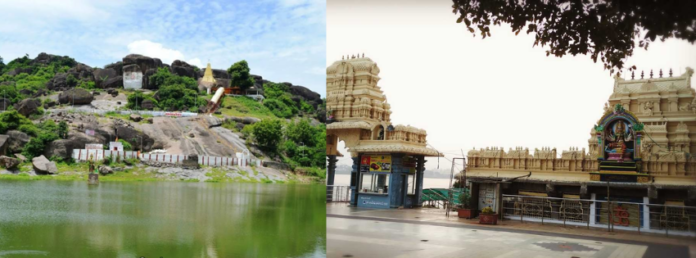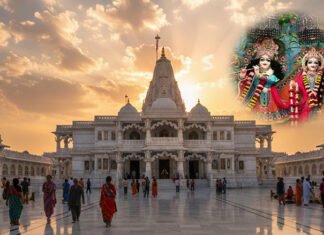Introduction:
Amidst the bustling streets of Warangal in Telangana, India, lies a serene sanctuary – the Padmakshi Temple. Perched atop a hillock in Hanamakonda, this ancient temple boasts a rich tapestry of history, captivating architecture, and profound spiritual significance. This article delves into the fascinating story of the Padmakshi Temple, unveiling its evolution, architectural marvels, and enduring legacy (Padmakshi Temple Telangana, Hanamakonda Padshmi Temple).
Also read: Experience the Spiritual Majesty of Bhadrakali Temple in Warangal
A Journey Through Time: From Shaivite Cave to Jain Shrine to Hindu Abode, Padmakshi Temple
The Padmakshi Temple’s origin story is as captivating as its architecture. Historical evidence suggests that the site may have initially served as a Shaivite cave temple, dedicated to Lord Shiva. However, the 12th century witnessed a significant transformation. Under the Kakatiya dynasty, known for supporting arts and architecture, the temple became a Jain shrine in 1117 CE. An inscription dating back to this period serves as a testament to the Jain influence on the site. The inscription and Jain iconography reveal the Padmakshi Temple’s earlier history.
Also read: Kolanupaka Temple: A Landmark of Jain Faith
The Intriguing Transformation: Unveiling the Duality of the Deities of Padmakshi Temple
Over time, the Padmakshi Temple underwent another metamorphosis. It was converted into a Hindu place of worship dedicated to Goddess Padmakshi, who is also revered as Padmavati. Padmakshi embodies the essence of Goddess Lakshmi, the Hindu deity associated with prosperity, fortune, and auspiciousness. Interestingly, the central idol itself has a unique history. Believed to be a Jain yakshini (guardian deity) named Amrakushmandini, the idol was reinterpreted as Padmakshi over time. This fascinating fusion of iconography underscores the temple’s unique position at the confluence of Jain and Hindu traditions.
Also read: An Ultimate Guide to the Kakatiya Architecture Thousand Pillar Temple
A Legacy Etched in Stone:
The Architectural Marvels of Padmakshi (Padmakshi Temple architecture) Stepping into the Padmakshi Temple complex is akin to stepping into a bygone era. Visitors are captivated by the Annakonda pillar, a striking black granite quadrangular structure guarding the entrance. This impressive pillar is a testament to the architectural prowess of the Kakatiya era. As you explore, intricate carvings of Jain Tirthankaras and other deities reveal the temple’s Jain heritage. The harmonious blend of architectural styles, from the towering pillar to the intricate carvings, creates a visually captivating experience.
Beyond Religious Boundaries:
The Enduring Significance of Padmakshi (Padmakshi Temple significance) The Padmakshi Temple transcends the boundaries of religion, serving as a place of solace and reverence for both Hindus and Jains. Locals affectionately address the goddess as “Amma” (mother), reflecting the deep devotion she inspires. This sense of inclusivity is further emphasized during the vibrant Bathukamma festival. During this annual celebration, lakhs of women throng the temple, offering colorful floral arrangements to the goddess. The vibrant display of flowers and the fervent devotion of the devotees create a truly spectacular spectacle (Bathukamma festival Padmakshi Temple).
A Climb to Tranquility: Locating the Padmakshi Temple
The Padmakshi Temple is situated in Hanamakonda, approximately 8 kilometers from Warangal city. Reaching the temple is a breeze, with options ranging from cars and rickshaws to buses. Be prepared for a short climb up the hillock, which offers breathtaking panoramic views of the city upon reaching the top. The climb itself adds to the spiritual experience, allowing visitors to shed worldly distractions and prepare themselves for a moment of peace within the temple sanctum.
Temple Timings of Padmkshi Temple
The Padmakshi Temple is open to visitors from sunrise to sunset, typically between 6:00 AM and 6:00 PM.
A Tapestry of Rituals and Festivals:
Beyond Bathukamma, the temple also thrives during Diwali and Navratri, celebrating the festival of lights and Durga Puja. The temple is adorned with colorful decorations during these festivals, and special aarti (worship rituals with lamps) are performed throughout the day. Devotees often offer prayers and gifts like coconuts, flowers, and sweets to the goddess, seeking blessings for prosperity, good health, and well-being.
Local Legends and Whispers of Magic: Padmakshi Temple
Local folklore adds another layer of intrigue to the Padmakshi Temple. Legends speak of the Annakonda pillar possessing magical properties. People believe that pouring water on the pillar during a specific astrological alignment, such as a full moon on a Monday in Shraavana (typically July-August), can bring good luck. While the scientific validity of this belief remains unproven, it adds to the temple’s mystique and the sense of wonder it evokes in visitors.
Another local legend whispers of a hidden tunnel connecting the Padmakshi Temple to another ancient temple in the region. While its existence remains unverified, it sparks the imagination and highlights the temple’s potential connection to a larger historical network.
Also read: Keesaragutta Temple: An Exclusive information of Ramalingeswara
Safeguarding the Past for the Future:
Restoration and Preservation Efforts The Padmakshi Temple is a testament to Telangana’s rich cultural heritage. To ensure its continued existence for future generations, the Archaeological Survey of India (ASI) is responsible for its upkeep and preservation. Recent restoration efforts have focused on cleaning and stabilizing the temple structure, ensuring the intricate carvings and architectural elements remain vibrant for years.
A Gateway to a Historical Tapestry: Nearby Attractions
A visit to the Padmakshi Temple can be a springboard to explore the wider historical tapestry of Warangal. History buffs can delve deeper into the Kakatiya dynasty’s legacy by visiting the majestic Warangal Fort, a testament to their architectural prowess. The intricately carved Thousand Pillar Temple offers another glimpse into the region’s artistic heritage. For those seeking a connection with nature, the Kakatiya Zoological Park provides a sanctuary for diverse flora and fauna.
A Spiritual Haven for All: The Enduring Allure of Padmakshi
The Padmakshi Temple in Warangal is more than just a place of worship; it’s a living testament to the enduring spirit of tolerance and the harmonious confluence of faiths. Its captivating history, architectural marvels, and vibrant traditions create a truly unique spiritual experience. So, on your next pilgrimage to Telangana, make sure to include the Padmakshi Temple in your itinerary. Ascend the hillock, immerse yourself in the temple’s captivating narrative, and discover the magic that awaits within this hidden gem.
A Beacon of Peace and Spiritual Renewal
The Padmakshi Temple transcends its historical significance and architectural beauty. It serves as a beacon of peace and spiritual renewal for devotees of all faiths. Whether seeking blessings for prosperity, solace in prayer, or simply a moment of quiet reflection amidst the bustling cityscape, the Padmakshi Temple offers a sanctuary for the soul. As you depart from the temple, carrying the echoes of chanting and the lingering fragrance of incense, you’ll leave with a renewed sense of perspective and a deeper appreciation for the rich tapestry of Indian culture and spirituality.
This revised ending emphasizes the temple’s spiritual significance beyond its historical and cultural aspects. It leaves the reader with a sense of peace and a desire to experience the temple firsthand.
FAQS
ANS) Padmashi Temple is situated atop a hillock in Hanamakonda, Telangana, India.
ANS) The presiding deity of Padmashi Temple is Goddess Padmavati, a form of Goddess Lakshmi
ANS) Padmashi Temple is a beautiful example of Kakatiya architecture, characterized by intricate carvings and ornate pillars.
ANS) The temple can be visited throughout the year, but the festive seasons of Navratri and Dussehra are particularly auspicious.
ANS) Padmashi Temple is believed to have been built during the Kakatiya dynasty and is considered a significant historical and religious site.











